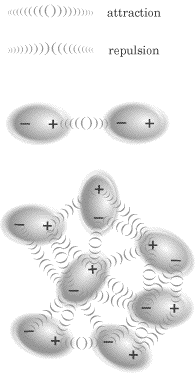Intra- and Intermolecular Forces
Whether a particular group of bonded molecules takes the form of a solid, liquid, or gas depends not only on the bonds that exist within each individual molecule, but also on the presence and type of bonds between molecules. Hark back to the different types of bonds we reviewed in the last chapter: ionic, covalent, and metallic. Of these, ionic bonds tend to be the strongest, and this means that substances that contain ionic bonds are solids at room temperature. Substances that are primarily made up of covalent bonds, which are weaker, can be solid or liquid, and their state will depend on the presence and type of intermolecular forces. The two main types of intermolecular forces that exist between molecules are dipole-dipole forces (including hydrogen bonds) and London dispersion forces. Dipole-Dipole Forces Dipole-dipole attractions take place when two or more neutral, polar molecules are oriented such that their positive (+) and negative (-) ends are close to each other.

Because of the attraction between unlike charges, this is a fairly strong type of intermolecular force, and molecules held together by dipole-dipole forces tend to be in the solid or liquid state. Also, for molecules that are about the same size and weight, the strength of the dipole-dipole forces increases as the degree of polarity increases. In other words, the more polar a molecule is, the stronger the dipole-dipole forces it will form with itself and other molecules. One very important and unique case of the dipole-dipole attraction is known as hydrogen bonding. Hydrogen bonds are not true bonds: they’re just strong attractive forces between the hydrogen on one molecule and a highly electronegative atom on a nearby molecule.

Hydrogen bonds most commonly form between hydrogen atoms and fluorine, oxygen, or nitrogen. This type of intermolecular force is responsible for water’s unique characteristics, such as its high specific heat and boiling point temperature—but more about that later. London Dispersion Forces—Weak Intermolecular Forces London forces are relatively weak forces of attraction that exist between nonpolar molecules and noble gas atoms, like argon (a noble gas) and octane (a hydrocarbon; C8H18). These types of attractive forces are caused by a phenomenon known as instantaneous dipole formation. In this process, electron distribution in the individual molecules suddenly becomes asymmetrical, and the newly formed dipoles are now attracted to one another.

The ease with which the electron cloud of an atom can be distorted to become asymmetrical is called the molecule’s polarizability. Think of this as a probability issue. The greater the number of electrons an electron has, the farther they will be from the nucleus, and the greater the chance for them to shift positions within the molecule. This means that larger nonpolar molecules tend to have stronger London dispersion forces. This is evident when you look at the diatomic elements in group 7, the halogens. All of these diatomic elements are nonpolar, covalently bonded molecules. Now, going down the group, fluorine and chlorine are gases, bromine is a liquid, and iodine is a solid! For nonpolar molecules, the farther you go down the group, the stronger the London dispersion forces.
(责任编辑:申月月)
视频学习
我考网版权与免责声明
① 凡本网注明稿件来源为"原创"的所有文字、图片和音视频稿件,版权均属本网所有。任何媒体、网站或个人转载、链接转贴或以其他方式复制发表时必须注明"稿件来源:我考网",违者本网将依法追究责任;
② 本网部分稿件来源于网络,任何单位或个人认为我考网发布的内容可能涉嫌侵犯其合法权益,应该及时向我考网书面反馈,并提供身份证明、权属证明及详细侵权情况证明,我考网在收到上述法律文件后,将会尽快移除被控侵权内容。



